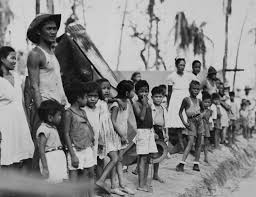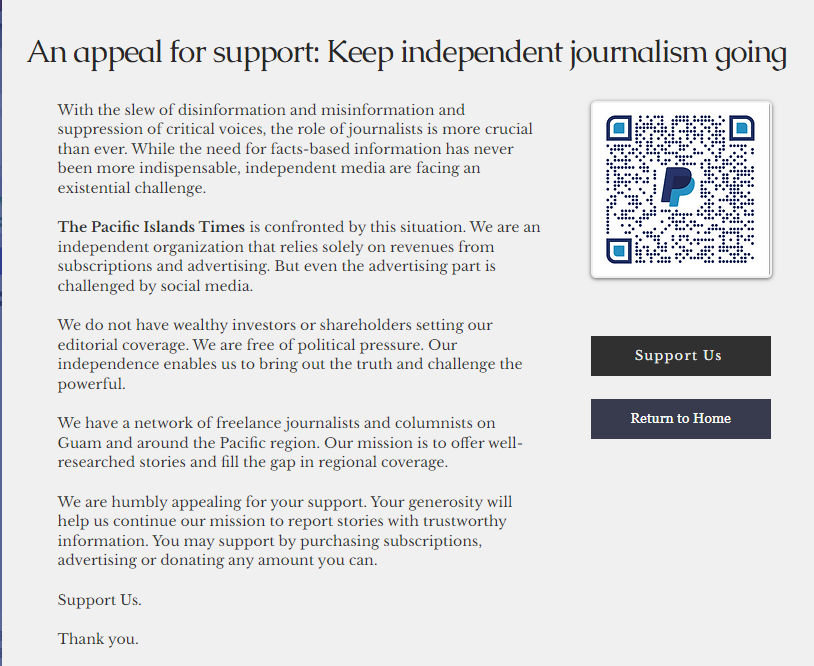By Mar-Vic Cagurangan
To this day, Joseph Mafnas is still trying to figure out how he survived WWII. He was barely one year old when he was rescued from one of the three caves in Kalaguak, an obscure spot in Barrigada, after the American forces liberated Guam from the Japanese Imperial Army. Mafnas is haunted by lingering sorrow for the other children hauled into the caves who didn’t get to live and see the end of the war.
“And the thing that makes me really sad is that,” said Mafnas, 81. “I’m still trying to find the answer: How did I survive during the Japanese invasion? And it’s really sad to continue thinking about what happened to all the others who didn’t make it through.”
While Guam commemorates the 80th anniversary of the island’s liberation from the Japanese forces on July 21, 1944, Mafnas will also mark the 80th anniversary of his own rescue.
Mafnas was among the children separated from their parents, who were subjected to forced labor by the Japanese Imperial Army. His father, Jose Mafnas, was among the men who were forced to build the airfield in Tiyan. His mother, Clotilde Mafnas, and other CHamoru women were forced to do laundry, cooking and other chores for the Japanese.

“My mom thought I was gone already because she had not seen me for some time,” Joseph Mafnas said.
After the liberation, Clotilde Mafnas found her son among the rest of the unrecognizably scraggly babies who had been transferred to a dispensary.
Kalaguak is now a memorial site. “I always go down there once in a while just to listen to those—I guess, how should I say this—the other kids and infants that were there with me, just to hear them crying. I think it’s their spirit,” he said.
Eighty years after the war, Mafnas said the war pains remain fresh. “To tell the story about the military is easy because you’re trained to defend the country, but to tell the story about what happened during the Japanese occupation is really hard,” said Mafnas, who served 40 years in the military.
The number of WWII survivors dwindles every year. The Guam Visitors Bureau and the Office of Sen. Jesse Lujan jointly launched Project Today to recognize and honor Guam's WWII survivors still living today who were on Guam during the Japanese occupation (1941-1944).
"Last Liberation Day when I sat down with [former] Gov. (Carl) Gutierrez at the GVB booth, we were talking about the dwindling number of war survivors,” Lujan said, noting that the former governor and former first lady Geri Gutierrez were war survivors themselves.
“We came up with the idea of honoring all the living war survivors here in Guam and wherever else they may be," the senator added.
As of this month, 463 certificates of recognition have been given out to war survivors in 11 villages, according to Lujan's office.

Most of the remaining survivors are now in their 80s and 90s. The oldest, Rita White, 102, lives in Piti. (She declined to be interviewed.)
With the world facing a heightened risk of another war, the remaining war survivors are passing the baton, telling their and their parents’ stories about the atrocities they suffered during the Japanese occupation and the consequences of the war that claimed thousands of lives.
The CHamoru population had suffered considerably. In what became known as the Maneggon March, the Japanese soldiers forced most of the island's population to march into six concentration camps in southern Guam. The sick and starving were left for dead along the way, and Japanese troops massacred about 600 civilians. As many as 2,000 may have been killed during the occupation. Guam was eventually liberated by American forces during the Battle of Guam, from July 21, 1944, to August 1944.
The recapture of Guam and the broader Pacific campaign destroyed much of Japan's naval air power and allowed the United States to establish large airbases from which it could bomb the Japanese home islands with its new strategic bomber, the Boeing B-29 Superfortress.
The remaining war survivors were either babies or young children during the time. The infants, who were devoid of clear memories of what happened during the war, learned the stories from their parents. Now the last line of storytellers, the wartime children are passing on the stories to the next generation.

Sitting next to her mother, Jacqueline Garrido shared her mother’s story. Her mother, Maria Garrido Hale, now 86, was six when she and her brothers escaped the Japanese during the Malesso march that resulted in the death of 46 CHamoru men. “Her brothers would carry her on their shoulders when they did the march to the mountains just to get away and be safe from the Japanese,” Jacqueline said.
Jacqueline’s grandfather, Ramon Garrido, was one of the men killed by the Japanese in Tinta Cave. “My grandmother was really hurt about her husband passing away,” Jacqueline said. “She asked me to promise her to continue to go to the Tinta. She said, ‘Can you promise me that as long as you can walk…until you are not healthy anymore?’ So I go there every year.”

Jesus M. Tainatongo was one year old during the war. He was born on Sept. 1, 1943, in the valley next to Tinta. “My mother suffered a lot during that time, trying to protect me,” he said. “My dad worked as a laborer at the airstrip. My father shared with me that he was scared because, they told me, the Japanese were going to kill my mom.” But some of the stories he learned from his parents are hazy now, he said.
He showed a scar on his arm. “This is from the vaccine. The Japanese required people to have a vaccine. Maybe it was because of a disease,” he said. “The thing hurt me. They really worked on my arm.”
After the war, the U.S. exonerated Japan on behalf of the people of Guam, a move that caused resentment among those who survived the Imperial Army’s atrocities. Guam was unable to get the federal government to pay war reparations; the local government took on the task.
Public Law 36-73, also known as “The Guam World War II Reconciliation Act of 2021,” established a locally implemented program to compensate survivors and descendants. The law appropriates $10 million from the general fund to the Guam War Claims Fund to pay certified claims to compensate Guam victims and survivors.
On June 28, the Guam Legislature presented a resolution honoring Guam’s war survivors. “We must forever honor the survivors that have gone before us, honor the survivors that are still with us and remind all of our future generations to never forget the lessons that we have learned from them,” Speaker Therese Terlaje said.
Correction: In the print edition, Sen. Jesse Lujan was identified as a war survivor. Sen. Lujna was born in 1955. Our sincere apologies.
Subscribe to
our digital
monthly edition















Comments